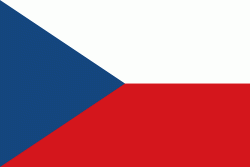Czech language
Czech (Czech čeština ), historically also Bohemian (lingua Bohemica in Latin), is a West Slavic language of the Czech–Slovak group, written in Latin script. Spoken by over 10 million people, it serves as the official language of the Czech Republic. Czech is closely related to Slovak, to the point of high mutual intelligibility, as well as to Polish to a lesser degree. Czech is a fusional language with a rich system of morphology and relatively flexible word order. Its vocabulary has been extensively influenced by Latin and German.
The Czech–Slovak group developed within West Slavic in the high medieval period, and the standardization of Czech and Slovak within the Czech–Slovak dialect continuum emerged in the early modern period. In the later 18th to mid-19th century, the modern written standard became codified in the context of the Czech National Revival. The main non-standard variety, known as Common Czech, is based on the vernacular of Prague, but is now spoken as an interdialect throughout most of the Czech Republic. The Moravian dialects spoken in the eastern part of the country are also classified as Czech, although some of their eastern variants are closer to Slovak.
Czech has a moderately-sized phoneme inventory, comprising ten monophthongs, three diphthongs and 25 consonants (divided into "hard", "neutral" and "soft" categories). Words may contain complicated consonant clusters or lack vowels altogether. Czech has a raised alveolar trill, which is known to occur as a phoneme in only a few other languages, represented by the grapheme ř.
Czech is a member of the West Slavic, a sub-branch of the Slavic branch of the Indo-European language family. This branch includes Polish, Kashubian, Upper and Lower Sorbian and Slovak. Slovak is the most closely related language to Czech, followed by Polish and Silesian.
The West Slavic languages are spoken in Central Europe. Czech is distinguished from other West Slavic languages by a more-restricted distinction between "hard" and "soft" consonants (see Phonology below).
The Czech–Slovak group developed within West Slavic in the high medieval period, and the standardization of Czech and Slovak within the Czech–Slovak dialect continuum emerged in the early modern period. In the later 18th to mid-19th century, the modern written standard became codified in the context of the Czech National Revival. The main non-standard variety, known as Common Czech, is based on the vernacular of Prague, but is now spoken as an interdialect throughout most of the Czech Republic. The Moravian dialects spoken in the eastern part of the country are also classified as Czech, although some of their eastern variants are closer to Slovak.
Czech has a moderately-sized phoneme inventory, comprising ten monophthongs, three diphthongs and 25 consonants (divided into "hard", "neutral" and "soft" categories). Words may contain complicated consonant clusters or lack vowels altogether. Czech has a raised alveolar trill, which is known to occur as a phoneme in only a few other languages, represented by the grapheme ř.
Czech is a member of the West Slavic, a sub-branch of the Slavic branch of the Indo-European language family. This branch includes Polish, Kashubian, Upper and Lower Sorbian and Slovak. Slovak is the most closely related language to Czech, followed by Polish and Silesian.
The West Slavic languages are spoken in Central Europe. Czech is distinguished from other West Slavic languages by a more-restricted distinction between "hard" and "soft" consonants (see Phonology below).
Country
-
Czech Republic
The Czech Republic, also known as Czechia, is a landlocked country in Central Europe. Historically known as Bohemia, it is bordered by Austria to the south, Germany to the west, Poland to the northeast, and Slovakia to the southeast. The Czech Republic has a hilly landscape that covers an area of 78871 km2 with a mostly temperate continental and oceanic climate. The capital and largest city is Prague; other major cities and urban areas include Brno, Ostrava, Plzeň and Liberec.
The Duchy of Bohemia was founded in the late 9th century under Great Moravia. It was formally recognized as an Imperial State of the Holy Roman Empire in 1002 and became a kingdom in 1198. Following the Battle of Mohács in 1526, the whole Crown of Bohemia was gradually integrated into the Habsburg monarchy. The Protestant Bohemian Revolt led to the Thirty Years' War. After the Battle of White Mountain, the Habsburgs consolidated their rule. With the dissolution of the Holy Empire in 1806, the Crown lands became part of the Austrian Empire.
